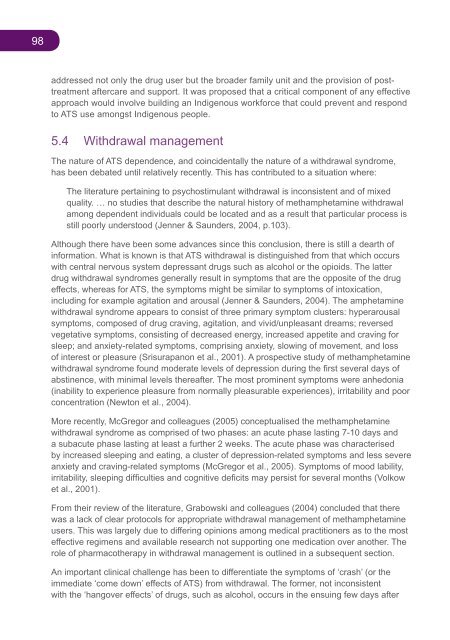National Amphetamine-Type Stimulant Strategy Background Paper
National Amphetamine-Type Stimulant Strategy Background Paper
National Amphetamine-Type Stimulant Strategy Background Paper
Create successful ePaper yourself
Turn your PDF publications into a flip-book with our unique Google optimized e-Paper software.
98<br />
addressed not only the drug user but the broader family unit and the provision of posttreatment<br />
aftercare and support. It was proposed that a critical component of any effective<br />
approach would involve building an Indigenous workforce that could prevent and respond<br />
to ATS use amongst Indigenous people.<br />
5.4 Withdrawal management<br />
The nature of ATS dependence, and coincidentally the nature of a withdrawal syndrome,<br />
has been debated until relatively recently. This has contributed to a situation where:<br />
The literature pertaining to psychostimulant withdrawal is inconsistent and of mixed<br />
quality. … no studies that describe the natural history of methamphetamine withdrawal<br />
among dependent individuals could be located and as a result that particular process is<br />
still poorly understood (Jenner & Saunders, 2004, p.103).<br />
Although there have been some advances since this conclusion, there is still a dearth of<br />
information. What is known is that ATS withdrawal is distinguished from that which occurs<br />
with central nervous system depressant drugs such as alcohol or the opioids. The latter<br />
drug withdrawal syndromes generally result in symptoms that are the opposite of the drug<br />
effects, whereas for ATS, the symptoms might be similar to symptoms of intoxication,<br />
including for example agitation and arousal (Jenner & Saunders, 2004). The amphetamine<br />
withdrawal syndrome appears to consist of three primary symptom clusters: hyperarousal<br />
symptoms, composed of drug craving, agitation, and vivid/unpleasant dreams; reversed<br />
vegetative symptoms, consisting of decreased energy, increased appetite and craving for<br />
sleep; and anxiety-related symptoms, comprising anxiety, slowing of movement, and loss<br />
of interest or pleasure (Srisurapanon et al., 2001). A prospective study of methamphetamine<br />
withdrawal syndrome found moderate levels of depression during the first several days of<br />
abstinence, with minimal levels thereafter. The most prominent symptoms were anhedonia<br />
(inability to experience pleasure from normally pleasurable experiences), irritability and poor<br />
concentration (Newton et al., 2004).<br />
More recently, McGregor and colleagues (2005) conceptualised the methamphetamine<br />
withdrawal syndrome as comprised of two phases: an acute phase lasting 7-10 days and<br />
a subacute phase lasting at least a further 2 weeks. The acute phase was characterised<br />
by increased sleeping and eating, a cluster of depression-related symptoms and less severe<br />
anxiety and craving-related symptoms (McGregor et al., 2005). Symptoms of mood lability,<br />
irritability, sleeping difficulties and cognitive deficits may persist for several months (Volkow<br />
et al., 2001).<br />
From their review of the literature, Grabowski and colleagues (2004) concluded that there<br />
was a lack of clear protocols for appropriate withdrawal management of methamphetamine<br />
users. This was largely due to differing opinions among medical practitioners as to the most<br />
effective regimens and available research not supporting one medication over another. The<br />
role of pharmacotherapy in withdrawal management is outlined in a subsequent section.<br />
An important clinical challenge has been to differentiate the symptoms of ‘crash’ (or the<br />
immediate ‘come down’ effects of ATS) from withdrawal. The former, not inconsistent<br />
with the ‘hangover effects’ of drugs, such as alcohol, occurs in the ensuing few days after

















